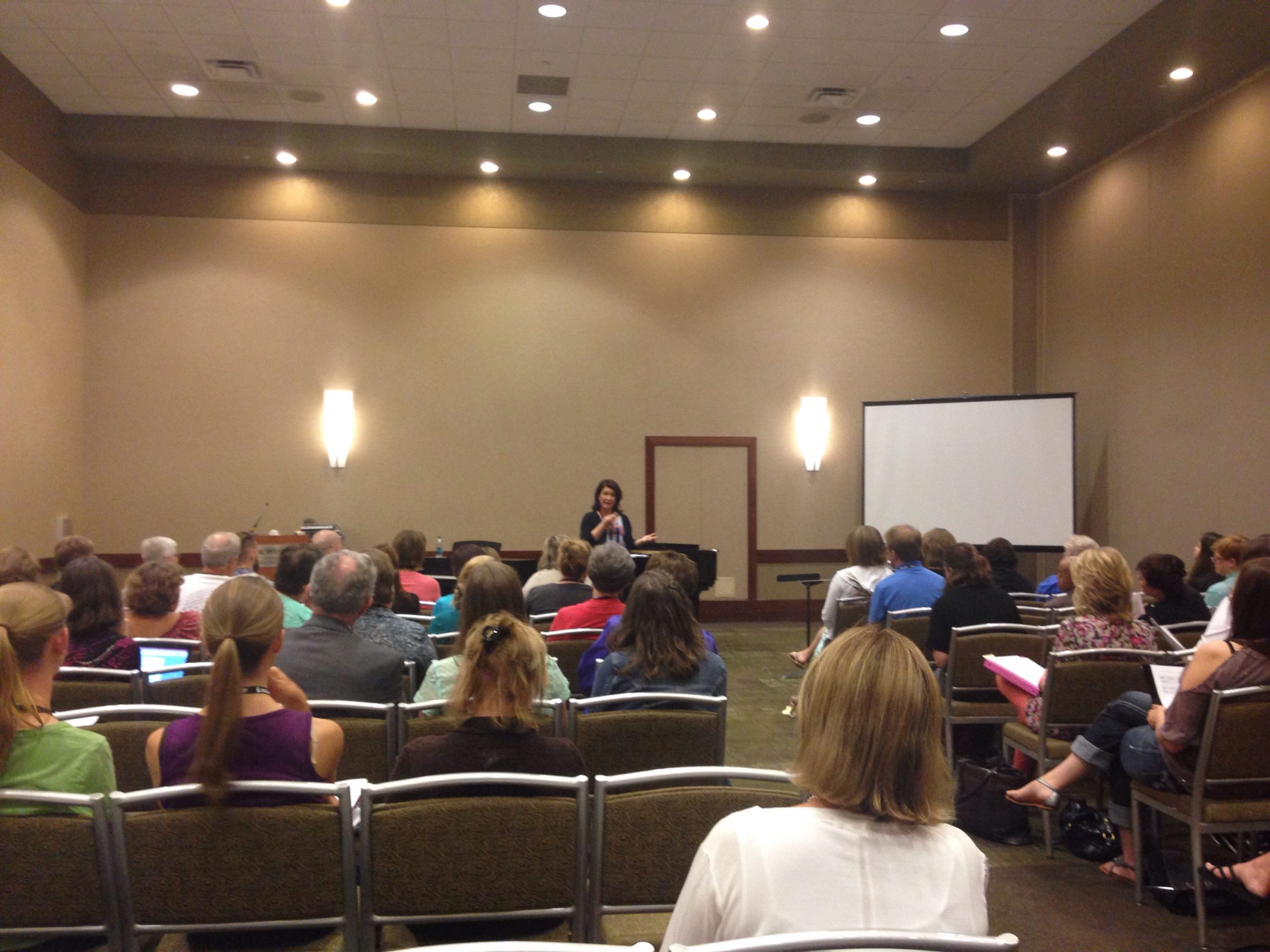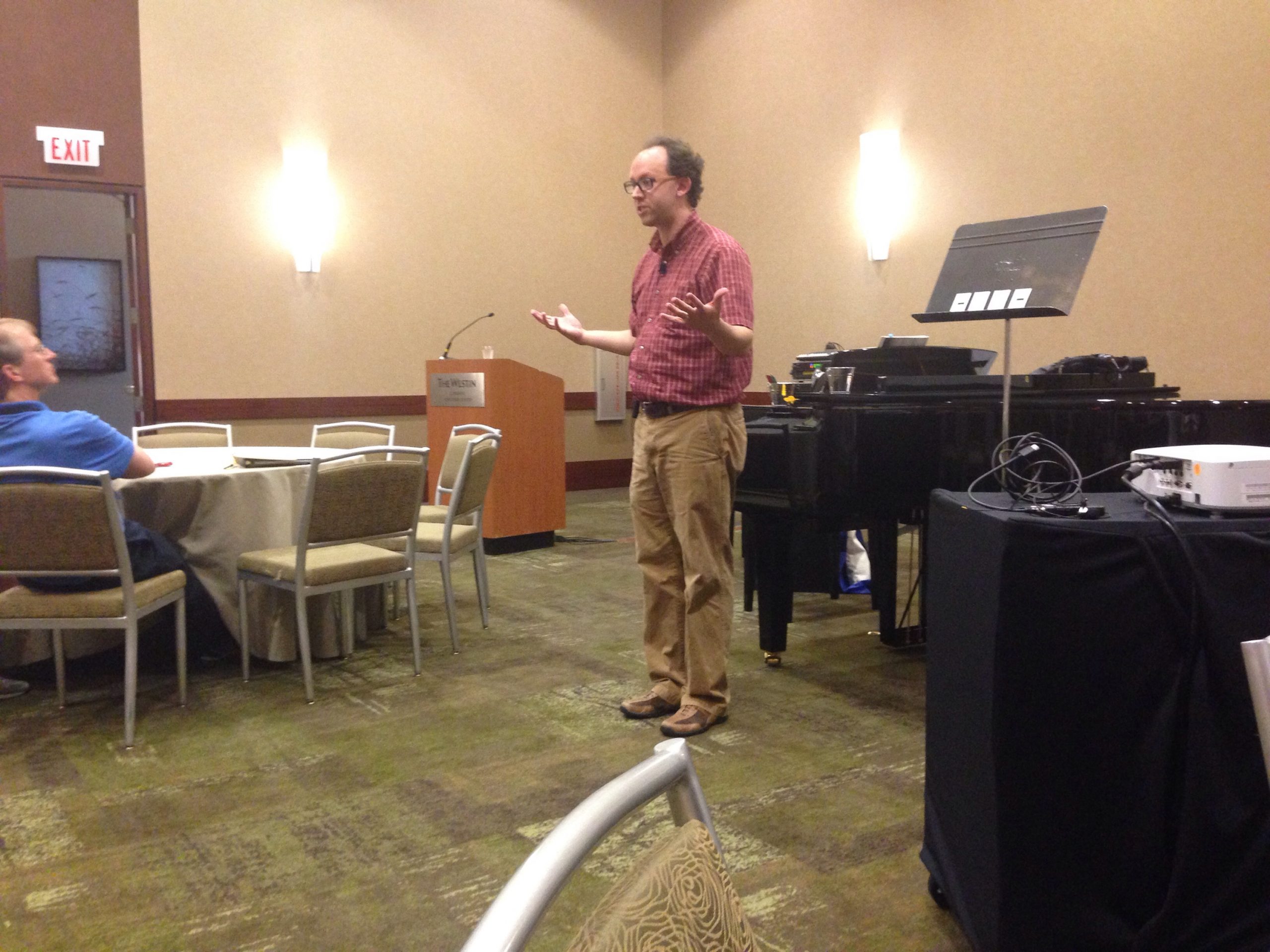Today, I traveled with my good friend Susan West to Lombard, Illinois to attend the 2015 National Conference on Keyboard Pedagogy. When we arrived, we met up with our other roommate, Amy Chaplin.
We attended the Independent Music Teachers track of the Pre Conference Seminars.
1:30: Marvin Blickenstaff – Keynote Address: The Many Faces of Music
In his wonderful and inspiring keynote for the day, Marvin discussed the many faces of music.
1. Music as Entertainment. We think of Haydn and Mozart as examples as those who composed music for entertainment purposes. But do we teach to entertain? Do we ask students that we choose repertoire for entertainment? Or musical growth and non musical values?
2. Music as Service. Music touches our soul and allows us to experience beauty. “The human soul needs music more than bread.”as teachers, are dedicated to the improvement of the lives of those around us through music. Our students can also use music as service: playing for nursing homes, etc. everyone has a need for music.
3. Music as Self-Expression. Why do we study? To explore the rich sounds of the great masters. As Richard Chronister once said (paraphrased): “Students take lessons for one reason: to learn to make exciting sounds at the piano. Every lesson that does not help this goal is cultivating a potential dropout.” We must remember to ask: “how does this piece make you feel? What is Kuhlau trying to say through this passage?” This should be the central goal of our lesson: to unlock expression in every piece.
4. Music as Education. Music training has great impact on brain development as well as emotional health and development. Music brings together the physical, emotional, and intellectual. Music education is an important part of holistic education.
5. Music as Art. There is artistry in every child. The goal of teaching is to produce artists. Those who feel and express beyond the page. We do not teach to entertain, we teach to give students the experience of expression and artistry. We live for those moments when listeners say that the music touches or speak to them. Even a beginner can achieve this, we can agree. Even our youngest students can play with great focus, sincerely, and artistry. When you hear it, you know it. For a moment, you are changed because the music has taken over your sensibilities.
What constitutes artistic students? Accuracy is not artistry. An artist looks behind the notes. All music expresses some aspect of the human emotion. Do you feel the sounds? What do you wish your listeners to feel? Dynamics, balance, and breath are the main three sounds that Marvin suggests make up artistry.
Music has many faces. We with our students engage in this faces together. But we do our students a disservice if we do not limit our instruction to entertainment, but to treat every student as an artist.
2:15 Pete Jutras – What Are We Really Teaching?
In his talk, Pete Jutras discussed a holistic approach to piano teaching, where elements such as ear training, rhythm, sigh-reading, and theory are approached and taught through the very repertoire the student is learning instead of necessarily through separate books or activities. Our natural responses to music centers on whole structures, so this approach to teaching makes sense. He encouraged us not to lose not use sight of the wholeness of music.
3:00 Arlene Steffan – Puzzle Pieces: Efficient and Effective Lesson Planning
Arlene’s presentation was based around the question: What can lesson planning do for my students? It was help us keep the big picture in mind for where you are going. It can help us keep track or goals and priorities.
As an example, Arlene describes how she planned yearly goals for one of her students, and then broke down those goals into semesterly goals. For example: finish Music Tree book 3, improve facility (speed and coordination), increase chord recognition, increase confidence. The semester goals would be to master sixteenth notes and triads and inversions (C G and D and their inversions).
Arlene then talked about possible ways to introduce a new pieces and having a plan for the mood, sound, and feeling the piece. Part of the lesson plan is considering what kinds of things we can talk about when introducing a new piece.
4:00 Richard VanDyke: Five Guiding Principles for the Technical Development of the Advancing Pianist
Richard’s talk focused on five principles that he feels are crucial technical development. He uses these five elements in his lesson, curriculum, and repoirtoirr planning. The five principles are: touch, sound, rhythm, facility, and balance.
When we teach, we should start with touc and sound. For example, even a beginner student can explore producing big sounds (thunderstorm) and soft sounds. Then: How do we sit at the keyboard? Rhythm work begins immediately. Facility and balance come somewhat later. All five stages must be worked on constantly with students.
Richard tales about the five elements in more specifics and describes how this mindset can be used when planning teaching and evaluating students’ playing and progress from year to year.
5:00 Elissa Milne: Repertoire Recipes
In her presentation, Australian teacher and composer Elissa Milne led us through considering the “ingredients” of various examples pieces of teaching pieces in order to teach our students to truly be able to create and express (or, “cook”!) with music. When we tweak and change ingredients, we learn to truly understand those components as well as be able to trulachieve greater range of expression through music.
Elissa’s handout provided excerpts of repertoire accompanied by lists of the ingredients that make up the piece. For example, in consideration of the well-known teaching piece “Bagpipe” (composer anonymous), she asked the audience: What could we do with the ingredient of the 5th in the LH? Broken, grace note, move the fifth down a whole step (mixolydian mode), inverting, etc. What if we changed it to ternary form instead of binary form? There are many possibilities. Instead of focusing on achieving accuracy, we want our students to think like chefs: what are the sound possibilities here? Elissa’s presentation was engaging and full of insight and practical examples for teaching with this kind of approach in mind.
7:30 Jason Sifford – Manipulation Stations
After a quick dinner, we returned for one more presentation, which was well worth our time! Jason Sifford demonstrated examples of creative and crafty manipulatives he has used to teach certain concepts and skills to his students. In groups, audience members worked together to try out his ideas for learning concepts such as melodic dictation, arm weight, legato finger transfer, and listening for harmonic change using popsicle sticks, matchbox cars, paper cutouts of dinosaurs, and more. It was fabulous!
Here, my roommates and I work with our group (including the fabulous Diane Hidy!), using the paper cutouts to listen for harmonic changes in a 12-bar Blues progression.









Thanks for sharing your conference notes – we can glean great tidbits from this.
Thank you so much for sharing. I look forward to your posts!
Thanks for the write-up! Good ideas! Such a great conference! Wish I could have been there.
Thank you so much for taking time to share. For those of us who couldn’t go, it’s very useful.
Thanks for sharing all of this!!
Wonderful synopsis Joy–thanks! Can you explain more about Jason Sifford’s presentation? It sounds so intriguing!
Hi Cara! I added one more photo to the end of the post which I neglected to post earlier, showing an example of a hands-on activity. Check it out! 🙂
Cool, thanks! I love the using manipulatives in lessons to teach concepts from a different angle, and am always looking to learn more along those lines. That’s one of the reasons I enjoy reading your blog, and would love to hear even more about it. 🙂 Thank you!
Thank you for sharing the sessions you attended so succinctly, Joy. I wish I had signed up for the preconfeeence and would love to know more about those manipulatives!